

June 2024 NewsletterISSN: 1933-8651
In this issue we present the following articles, news, announcements, and reviews:
|
Articles, Essays, and Reports
News and Announcements
Conferences and Calls for Papers
New Books
Book Reviews
|
African Diaspora Heritage in the Americas
By Christopher C. Fennell

This overview addresses a remarkable diversity of legacies and heritage for African diaspora populations in the Americas. Overcoming the horrors of the trans-Atlantic slave trade, captive Africans further developed myriad forms of cultural knowledge and practices drawn from their homeland cultures and conveyed those aspects of heritage to their descendants and social affiliates. Special knowledge of agricultural industries led to transformed landscapes. Resilience and fights for freedom were represented in self-emancipation, rebellion communities, reverence of burial grounds, and commemorations of lost settlements and ancestors across terrains and seascapes. Elements of cosmologies from multiple African cultures were integrated to form new religions and forms of cultural heritage. Over the past six centuries African diaspora peoples have pursued vitality in their cultural heritage and continue to fight for reparative justice to address European colonial wrongs.
A final form of this paper will be published as Chapter 12 in the peer-reviewed Routledge Handbook of Critical African Heritage Studies, edited by Ashton Sinamai, John Giblin, Shadreck Chirikure, and Ishanlosen Odiaua. London: Routledge (2024). From the publisher: "This handbook is a foundational reference point for critical heritage research about Africa and its diaspora. Foregrounding the diversity of knowledge systems needed to examine heritage issues in such a diverse continent, the contributors to this volume: argue for an understanding heritage that is at once both natural and cultural, tangible and intangible, political and dissonant, going beyond the physical and objective to include subjective narratives, performances, rituals, memories and emotions; examine the pre-coloniality, coloniality, post-coloniality, and decoloniality of current African heritage discourses and their consequences; analyse how heritage legislation derived from colonial law is compatible or otherwise with how heritage is perceived, identified and remembered in African communities; discuss questions of repatriation, restitution and reparations in relation to the return of artefacts from Western countries; illuminate the importance of ‘difficult heritage' within Africa and its diaspora; and consider the role of heritage for development in Africa. Making a crucial contribution to our understanding of African conceptions and practices of heritage, this book is an important read for scholars of African Studies, heritage and museum studies, archaeology, anthropology and history."
[Read or download this full article in Adobe format >>>].
[Return to table of contents]
Paradoxes in Designs for New Philadelphia National Historic Landmark
By Kathryn O. Fay and Christopher C. Fennell
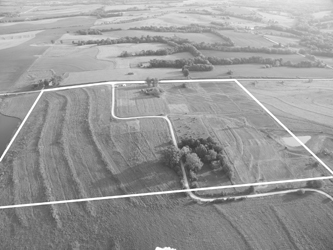
New Philadelphia, Illinois, established in 1836 by Frank McWorter, was the first town planned in advance and legally founded by an African American in the United States. The history of this community entails compelling stories of African Americans and European Americans residing in a town founded by an exceptional figure during times of extreme racism. Members of the local and descendant communities, archaeologists, historians, and genealogists have worked together for the past decade to advance research into this remarkable crossroads of families, merchants, farmers, and artisans, and to enhance their place in our national memory and heritage. In considering ways to present the town site and its lessons to broad audiences of visitors, divergences in design preferences can emerge among popular views held by community members and professionals. This article reproduces the study as originally published in Museums & Social Issues 7(2): 323-40 (2012) (link).
[Read or download this full article in Adobe format >>>].
[Return to table of contents]
Forging Connections at Catoctin Ironworks, Maryland
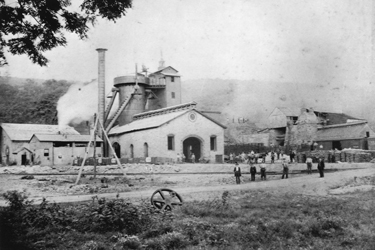 By Andrew Curry
By Andrew Curry
Science, August 2023.
DNA from enslaved Black workers at a 19th century iron forge links them to living descendants. But the research swirls with ethical questions.
Hanson Summers first appears in Maryland archives in 1834, when an inventory from Catoctin Furnace, an iron smelter in the ore-rich foothills of Maryland's Blue Ridge Mountains, lists an enslaved 17-year-old boy by the name of "Henson." Fifteen years later, the furnace's owners mention in a handwritten ledger that Henson was being sold for $500 to another iron smelter nearby. Then, in 1899, an obituary in the Hagerstown, Maryland, newspaper lauds Hanson Summers, age 82, who "was noted for his great strength and thought nothing of wheeling half a ton. . . . He was employed at the Antietam Iron Works."
Summers's story of survival and ironworking skill was uncovered by genealogists and historians hoping to tell the story of Black workers at Catoctin Furnace, a hellish place centered on a three-story furnace kept burning for months at a time. Genealogists from the Catoctin Furnace Historical Society tracked down Summers's descendants, including his 86-year-old great-great-granddaughter, Agnes Jackson. On Juneteenth this year, Jackson and her daughters drove to Catoctin for the first time from their homes in nearby Hagerstown.
"We never knew we were connected to people here," Jackson says, sitting on a folding chair in a small museum dedicated to the forge and its history. "[Our ancestors] were enslaved -- it wasn't a topic people wanted to talk about."
Last year, Jackson, who identifies as African American, also took a DNA test: She hoped to learn whether she and her daughters are related to any furnace workers who were buried in a small cemetery near the site. For the first time, answering such a question may be possible, thanks to a new study of DNA of 27 people from that cemetery published today in Science (also see related Perspective).
Other analyses of the bones had already offered a glimpse of the harsh lives of enslaved people in an industrial setting. Now, researchers have partnered with the consumer DNA testing company 23andMe to compare the ancient Catoctin Furnace genomes to those of almost 10 million living people in the company's database. They have identified 41,799 relatives, including hundreds of potential direct descendants. But the company hasn't yet notified any descendants about their results, as it works through the ethics of contacting people who agreed to let their data be used in anonymized studies. At the same time, researchers are wary of traumatizing people unprepared for links to enslaved ancestors.
Many in the Black community say such information -- when collected with community consent -- would have poignant value. "For marginalized communities whose history has been obscured, this technology can be leveraged to tell their stories," says Jada Benn Torres, a Black biological anthropologist at Vanderbilt University who was not part of the new study. "There's a beauty in connecting the past to the present."
[Read this full article online >>>].
[Return to table of contents]
Ancestry Releases Records of 183,000 Enslaved Individuals in America
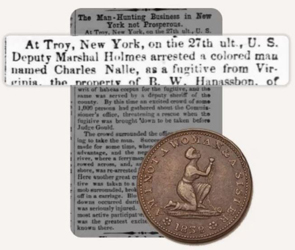 By Sarah Kuta
By Sarah Kuta
Smithsonian, June 11, 2024.
The genealogy company has digitized and published 38,000 newspaper articles from between 1788 and 1867 -- before Black Americans were counted as citizens in the U.S. census.
Thanks to the rise of commercial genealogy platforms, millions of Americans are now researching their family histories. However, for many Black Americans, the process can be challenging, if not impossible, because of insufficient documentation describing their enslaved ancestors.
Now, a newly released database of historic records may help fill in some of those gaps. This week, Ancestry published 38,000 newspaper articles containing the names, ages, physical descriptions and locations of more than 183,000 enslaved people in America.
"Sometimes data can feel impersonal, but what this significant number really represents is over 183,000 formerly enslaved individuals -- people who may not have been named or recognized since the original newspaper publications," Nicka Sewell-Smith, a genealogist and senior story producer for Ancestry, tells Smithsonian magazine.
The collection, called "Articles of Enslavement," is free for anyone to access online. Ancestry has already digitized more than 18 million records related to formerly enslaved or newly emancipated individuals, drawn from sources such as the Freedmen's Bureau and the United States census.
The newly published documents, which cover the years between 1788 and 1867, could help Black families across the country who are interested in tracing their roots. Some Black Americans appeared on census dating back to the first of its kind, but they weren't included holistically, or even as citizens until 1870. Records from before that year can be scarce, though not unlikely to come across. "Ancestry tracing often leads to dead ends, uncertainty and more questions, especially when it comes to identifying the enslaved," as Tracy Scott Forson wrote for Smithsonian earlier this year.
As such, to find information from before 1870, Black families often need documents other than census records—which the new Ancestry collection might be able to help with. More broadly, the documents could also provide historians with new insights into chattel slavery in the U.S.
[Read this full article online >>>].
[Return to table of contents]
Journal of African Diaspora Archaeology and Heritage Updates
 Many thanks to Lydia Wilson Marshall for her excellent work as editor of the journal for the past few years! Lydia will join our editorial board on July 1, 2024, and Chris Fennell will resume his past role as editor.
Many thanks to Lydia Wilson Marshall for her excellent work as editor of the journal for the past few years! Lydia will join our editorial board on July 1, 2024, and Chris Fennell will resume his past role as editor.
Enjoy some of our recent articles:
"Medicine, Reproduction, and Women’s Health at the Orange Valley Plantation, Jamaica," by Jacqueline Woodruff, Richard Veit, and Nicola Kelly
https://doi.org/10.1080/21619441.2024.2347082
"Renegotiating and Theorizing Heritage in the Context of 'Disaster' in the Caribbean: The Entanglement of Haitian Disaster-Related Histories," by Joseph Sony Jean and Jerry Michel (open access)
https://doi.org/10.1080/21619441.2023.2301153
"Transformation and Resistance: African Diaspora Archaeology in Brazil," by Lucio Menezes Ferreira and Luis Symanski
https://doi.org/10.1080/21619441.2022.2159377
"African Presence in Portugal: People and Things Within Material, Social, and Power Relations," by Tânia Manuel Casimiro, Francisco Curate, and Nathalie Antunes-Ferreira
https://doi.org/10.1080/21619441.2023.2290811
"Excavating Enslavement in the Garden State: Historical Archaeology of an Eighteenth and Nineteenth Century Plantation Near Trenton, New Jersey," by Nicholas Wekselblatt and George M. Leader
https://doi.org/10.1080/21619441.2023.2182345
[Return to table of contents]
Graduate Programs in African Diaspora Archaeology
By Christopher Fennell
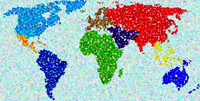
This catalog presents a compiled list of graduate school programs that can provide concentration in African diaspora archaeology. There are currently very few programs that formally offer a graduate degree specializing in this subject area, but there exist many programs that offer graduate degrees in archaeology which have faculty who specialize in African diaspora studies. The list set out below was compiled based on published directories, information provided by the departments, and details sent to the author. This list of programs and of related faculty within each program focuses on the US and UK and is not exhaustive or a full compilation of all departments. Other programs can be found at universities in locations, for example, in the Caribbean and South America. If you are aware of other graduate programs in African diaspora archaeology not listed below, or of additional details concerning those that are listed, please contact the author so he can include such information in future compilations.
[Read or download this full article here in Adobe .pdf format >>>].
[Return to table of contents]
"I've Known Rivers": The Ecologies of Black Life and Resistance
12th Biennial Conference and 25th Anniversary
Association for the Study of the Worldwide African Diaspora (ASWAD)
October 29 to November 2, 2025, St. Louis, Missouri
Call for Papers
Our host site, Saint Louis, sits at the confluence of two iconic rivers, the Mississippi and the Missouri. These continuously moving waterways have carved into the landscape, reshaping the bedrock that guides humans, plants and animals together. They can yet prove unpredictable as their banks rise and retreat as they nourish and cleanse. ASWAD's 2025 Conference theme takes as its inspiration the river, and waterways, as an analytical framework for Black lives past and present. In addition to Langston Hughes's poem, Vincent Harding's book, There is a River suggests the river as a metaphor for Black freedom struggle. Rivers are "powerful, tumultuous, and roiling with life; at other times meandering and turgid, covered with the ice and snow of seemingly endless winters." At its best, the Black freedom struggle "has moved consistently to the ocean of humankind's most courageous hopes for freedom and integrity."
Suggested Subfields: Black freedom and ecological justice; Black feminist eco-ethics; Plant and animal life; Maritime cultural landscapes; Gender and Environment; Afro-Maritime/Marine Spiritualities and Philosophies; Ethno-racial policies against Black rural populations, farmers, and maroon-descendants; Rivers of change: Ferguson and the long histories of Black freedom struggles; Streams of music: converging musical genres.
We encourage the submission of full panels. In your proposal, please indicate which of the above topic(s) you will address. All applications should include a one-page paper abstract, a short cv (3 pp maximum) for each presenter, and a one-page document that addresses the overall panel theme.
To submit your proposal, visit https://convention2.allacademic.com/one/aswad/aswad25/
Review of proposals will begin September 3, 2024. All proposals should be submitted by October 11, 2024. Acceptances will be issued on a rolling basis. We encourage multidisciplinary panels defined by diversity across identity markers, including but not limited to age, race, gender, sexuality, ability, academic rank, language, and geographies among others. Individuals may participate in up to two different ways – e.g. as a panellist and chair, a panellist and discussant, etc. To submit a proposal and to present at the conference, your ASWAD membership must be current. If you have any questions, please contact aswadconference@aswadiaspora.org
[Return to table of contents]
Society for Black Archaeologists Conference
September 14, 2024, Online
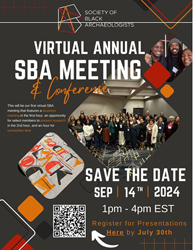
The Society of Black Archaeologists (SBA) invites all members to submit presentations for our annual meeting, which will be held virtually on Saturday, September 14, 2024 from 1:00-4:00pm (ET). Register for presentations online (link).
Following our annual business meeting, SBA members will have the opportunity to present 10 minute papers or multimedia presentations. Submissions from both terrestrial and underwater settings and from all geographical areas will be considered, but we will prioritize submissions addressing Black, African Diaspora, and African heritage.
The SBA requests that all submissions be completed using the online form by July 30, 2024. After that time, accepted presenters will be notified and provided with further details. If you have any questions or would like more information about the annual meeting, please contact the SBA President Elect at presidentelect@societyofblackarchaeologists.com or the SBA Secretary at secretary@societyofblackarchaeologists.com.
[Return to table of contents]
Cambridge History of Black Women in the United States
Call for Papers
Contributors are being solicited for the newly commissioned Cambridge History of Black Women in the United States. The Cambridge History of Black Women in the United States (CHBW) is a five-volume history that will appeal to students, lay readers, and specialists. These volumes will be a landmark opportunity to reflect seriously on the state of scholarship on Black women in the United States, as well as reshape our thinking about their impact on American society. We want to showcase the best work of recent years, as well as point the way forward for a new generation of scholars and readers. We see this as a scholarly project that aims to lead the field, and to educate and engage a broad audience of non-professionals.
Volume One: Contexts (1500-1800) examines the period from 1500-1800. We seek submissions that examine Black women in the context of the making of the African diaspora, Black women's resistance, gender and reproduction, religion, and Black women's lives and labors.
Volume Two: Bondage and Resistance (1800-1860) focuses on the myriad experiences of free Black and enslaved women, the gendered dimensions of the domestic slave trade, marriage, family, religion, Black women's resistance, Black girlhood, Black feminism, Black internationalism, and Black women's labor.
Volume Three: Transformations (1860-1900) surveys the Civil War through the end of the nineteenth century focusing on the impact of the Civil War and emancipation on Black women, Black women's leadership in the reparations movement, marriage, family, religion, Black women's organizing, Black women and banking, Black women and the carceral state, and the ways in which Black women navigated and protested Jim Crow.
Volume Four: Lifting As We Climb (1900-1945) assesses the period from 1900-1945 focusing on the impact of Black women on women's suffrage, education, migration, art, religion, literature, civil rights, their roles during World War I and World War II, Black women and the carceral state, and Black internationalism.
Volume Five: Social and Political Movements (1945-2020) interrogates the impact of Black women on the Civil Rights movement, the Black Power and Black Arts movement, literature, education, science, music, sports, religion, Black feminism, Black quotidian life, Black women's queer history, reproductive justice, health and wellness, Black women and the carceral state, and Black women's political activism during the twentieth and twenty-first century.
Interested persons should submit an abstract and two page CV to the General Editor, Dr. Karen Cook Bell at kcookbell@bowiestate.edu with the subject line "Cambridge History of Black Women." Volume Editors include Drs. Catherine Adams, Felicia Thomas, Nikki Taylor, Crystal Webster, Crystal Feimster, Hilary Green, Ashley Preston, Sheena Harris, Crystal Sanders, and Hettie V. Williams. Contact Information: Dr. Karen Cook Bell, 14000 Jericho Park Road, Department of History and Government, Bowie State University, Bowie, MD 20715; Contact Email kcookbell@bowiestate.edu.
[Return to table of contents]
Black Feminist Truth Telling:
Stories, Statements, and Collective Meaning Making
Call for Papers
Guest Editor: Dr. Stephanie Y. Evans, Georgia State University. Deadline: July 1, 2024.
"To tell the flat-footed truth means to offer a story or statement that is straightforward, unshakable, and unembellished." – Patricia Bell-Scott and Johnson-Bailey, Flat-Footed Truths: Telling Black Women's Lives.
Global Black Thought, the official journal of the African American Intellectual History Society (AAIHS), is now accepting submissions for a special issue that traces the changes and continuity of truth telling in Black feminist thought. Consensus is never the goal of scholarship, but Black feminist writing communities comprise critical spaces for telling what Black feminist scholar Patricia Bell-Scott refers to as "flat-footed truths." And these truths thrive in community. In this special issue, authors will explore truth telling as a practice of Black feminism in the US and across the Black Diaspora. Specifically, this volume allows an interdisciplinary community to consider what it means to present information that is, as Bell-Scott identifies, "straightforward, unshakable, and unembellished."
We are witnessing the enduring presence of forces that are deeply invested in misdirection, misinformation, loaded questions, faulty logic, unethical research, double standards, character assassination, and targeted attacks to discredit scholarship that exposes the lies of racism, sexism, capitalism, and colonial power. Truth telling is a form of "faithful witnessing," which Afro-Latina literary scholar Yomaira C. Figueroa-Vásquez describes in Decolonizing Diasporas as a "political act that aligns itself with feminist and decolonial epistemologies." Identifying feminist flat-footed truths in the African diaspora is a practice of witnessing.
With a focus on intellectual history, this issue constitutes a regenerative discussion: scholars are encouraged to not only discuss truth in the context of place, but in the context of time. Regenerative scholarship places contemporary Black feminist truth telling in a continuum with both ancestors and descendants. In The Souls of Black Folk, W. E. B. Du Bois argued, "The thinker must think for truth, not for fame." In a world obsessed with attention, monetizing content creation, and profiteering from the information economy, this issue of Global Black Thought offers scholars an opportunity to gather in a learning community and think about Black feminist meanings of truth.
Topics include (but are not limited to) the following: Black feminist truths about human rights, genocide, war, and peace; Black feminism, truth, and legal precedent; Truth and lies in Black feminist fiction and life writing; Conflicting definitions of Black feminist truth in transnational contexts; Truths that Black feminist writing expose; Truths that Black feminist writing hide; Black feminist intellectual activism in contrast to other types of activism; Truth, archives, and receipts; AI, ChatGPT, and Black feminism; Research methods, #CiteBlackWomen, #CiteASista, peer review, and plagiarism; Black feminism and truth in journalism; "Spilling the tea" and other locations of Black queer and trans intellectual history; Truth and consequences in Black feminist politics; Truth telling in creative, entertainment, and cultural contexts; Black feminist truth and reconciliation.
For questions about this special issue, please contact Guest Editor, Dr. Stephanie Y. Evans (professorsevans@gmail.com). For general inquiries about the journal, please contact the editing team (GBTJournal@aaihs.org). Follow this link to submit articles to the journal. More details about the journal can be found here. You can also join the journal's email list here to stay abreast of updates. Contact Email: GBTJournal@aaihs.org. https://globalblackthought.scholasticahq.com/for-authors.
[Return to table of contents]
New Book
Voodoo: An African American Religion
By Jeffrey E. Anderson
LSU Press
272 pp., ISBN-13 978-0807181324, 2024.
Description from the Publisher:
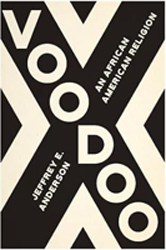 Despite several decades of scholarship on African diasporic religion, Voodoo remains underexamined, and the few books published on the topic contain inaccuracies and outmoded arguments. In Voodoo: An African American Religion, Jeffrey E. Anderson presents a much-needed modern account of the faith as it existed in the Mississippi River valley from colonial times to the mid-twentieth century, when, he argues, it ceased to thrive as a living tradition.
Despite several decades of scholarship on African diasporic religion, Voodoo remains underexamined, and the few books published on the topic contain inaccuracies and outmoded arguments. In Voodoo: An African American Religion, Jeffrey E. Anderson presents a much-needed modern account of the faith as it existed in the Mississippi River valley from colonial times to the mid-twentieth century, when, he argues, it ceased to thrive as a living tradition.
Anderson provides a solid scholarly foundation for future work by systematizing the extant information on a religion that has long captured the popular imagination as it has simultaneously engendered fear and ridicule. His book stands as the most complete study of the faith yet produced and rests on more than two decades of research, utilizing primary source material alongside the author's own field studies in New Orleans, Haiti, Cuba, Senegal, Benin, Togo, and the Republic of Congo. The result serves as an enduring resource on Mississippi River valley Voodoo, Louisiana, and the greater African Diaspora.
[Return to table of contents]
New Book
Memory and Power at L'Hermitage Plantation: Heritage of a Nervous Landscape
By Megan M. Bailey
University Press of Florida
196 pp., ISBN-13 978-0813069951, 2024.
Description from the Publisher:
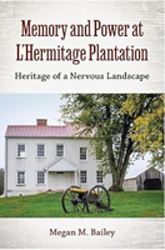 This book documents the treatment of enslaved people at L'Hermitage Plantation in Maryland from 1794 to 1827, showing how the plantation owners' strategies to maintain power and control can be seen in the spatial landscapes of the site.
This book documents the treatment of enslaved people at L'Hermitage Plantation in Maryland from 1794 to 1827, showing how the plantation owners' strategies to maintain power and control can be seen in the spatial landscapes of the site.
In this book, Megan Bailey uses archaeological data and historical records to document the treatment of enslaved people at L'Hermitage Plantation in Maryland from 1794 to 1827. Bailey uses the concept of the “nervous landscape”—a space where power is not absolute and where resistance is possible—to show how the Vincendière family's fear of losing control of their workforce drove their brutality.
Bailey shows how the Vincendières' strategies to maintain their power were inscribed in the plantation's landscapes through the design of the enslaved peoples' village, which maximized surveillance and control while suppressing individuality. Despite the family's behavior, enslaved people found ways to exercise agency, including through use of yard space, forming relationships with local residents, and running away. Considering fear and anxiety as a fundamental element of the colonial experience, Bailey argues that emotion should be considered in archaeological analyses of the past.
Today, L'Hermitage Plantation is a part of the Monocacy National Battlefield operated by the National Park Service. Bailey discusses the public interpretation of the site and how excavations of the plantation highlighted a more complicated narrative than the prevailing story of Civil War conflict and heroism. Memory and Power at L'Hermitage Plantation uses archaeology to connect the Vincendières to the present-day landscape in a complex, layered narrative of precarity and control.
[Return to table of contents]
New Book
Local Voices, Global Debates: The Uses of Archaeological Heritage in the Caribbean
Edited by Joseph Sony Jean and Eduardo Herrera Malatesta
Brill Academic Press
244 pp., ISBN-13 978-9004692930, 2024.
Description from the Publisher:
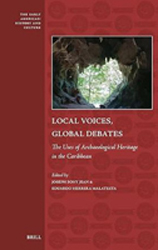 What is the role of local Caribbean individuals and communities in creating and perpetuating archaeological heritage? How has archaeological knowledge been integrated into education plans in different countries? This book aims to fill a gap in both archaeological scholarship and popular knowledge by providing a platform for local Caribbean voices to speak about the archaeological heritage of their region. To achieve this, each chapter of the book focuses on identifying and developing strategies that academics, heritage practitioners, and non-scholars from the insular Caribbean can adopt to stimulate a necessary dialogue on how archaeological heritage is used and produced on various academic, political, and social levels.
What is the role of local Caribbean individuals and communities in creating and perpetuating archaeological heritage? How has archaeological knowledge been integrated into education plans in different countries? This book aims to fill a gap in both archaeological scholarship and popular knowledge by providing a platform for local Caribbean voices to speak about the archaeological heritage of their region. To achieve this, each chapter of the book focuses on identifying and developing strategies that academics, heritage practitioners, and non-scholars from the insular Caribbean can adopt to stimulate a necessary dialogue on how archaeological heritage is used and produced on various academic, political, and social levels.
An ebook version is available in open access: https://brill.com/display/title/69861.
[Return to table of contents]
New Book
Materializing Colonial Identities in Clay:
Colonoware in the African and Indigenous Diasporas of the Southeast
Edited by Jon Bernard Marcoux and Corey A. H. Sattes
University Alabama Press
296 pp., ISBN-13 978-0817321901, 2024.
Description from the Publisher:
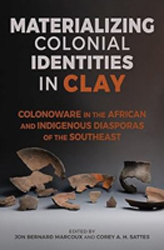 In Materializing Colonial Identities in Clay, Jon Bernard Marcoux, Corey A. H. Sattes, and contributors examine colonoware to explore the active roles that African Americans and Indigenous people played in constructing southern colonial culture and part of their shared history with Europeans.
In Materializing Colonial Identities in Clay, Jon Bernard Marcoux, Corey A. H. Sattes, and contributors examine colonoware to explore the active roles that African Americans and Indigenous people played in constructing southern colonial culture and part of their shared history with Europeans.
Colonoware was most likely produced by African and Indigenous potters and used by all colonial groups for cooking, serving, and storing food. It formed the foundation of colonial foodways in many settlements across the southeastern United States. Even so, compared with other ceramics from this period, less has been understood about its production and use because of the lack of documentation. This collection of essays fills this gap with valuable, recent archaeological data from which much may be surmised about the interaction among Europeans, Indigenous, and Africans, especially within the contexts of the African and Indigenous slave trade and plantation systems.
The chapters represent the full range of colonoware research: from the beginning to the end of its production, from urban to rural contexts, and from its intraregional variation in the Lowcountry to the broad patterns of colonialism across the early American Southeast. The book summarizes current approaches in colonoware research and how these may bridge the gaps between broader colonial American studies, Indigenous studies, and African Diaspora studies.
A concluding discussion contextualizes the chapters through the perspectives of intersectionality and Black feminist theory, drawing attention to the gendered and racialized meanings embodied in colonoware, and considering how colonialism and slavery have shaped these cultural dimensions and archaeologists' study of them.
[Return to table of contents]
New Book
Making a Way Out of No Way: Lives of Labor, Love, and Resistance
By Merideth M. Taylor
New Village Press
208 pp., ISBN-13 978-1613322406, 2024.
Description from the Publisher:
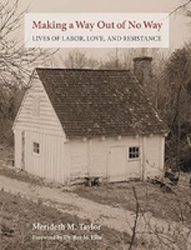 A richly imagined, photo illustrated narrative of 150 years of life in slavery on tobacco plantations in Southern Maryland.
A richly imagined, photo illustrated narrative of 150 years of life in slavery on tobacco plantations in Southern Maryland.
For over 165 years, plantation owners in Southern Maryland depended on the labor of enslaved men, women, and children to bring in the tobacco crop. The photographs and stories in this book grew out of the author's quest to understand how these people, who were subjected to a system that made every attempt to brutalize and dehumanize them, were able not only to survive but to build families and meaningful lives. Author Merideth Taylor has created a credible, well-researched, richly imagined world that is both informative and moving. The traditional central figure and linear plot of the novel has been replaced by an interwoven collage of scenes and community of characters, that reflect the diversity of experience, “silences,” and incompleteness of the historical record. Her choice to largely avoid graphic depictions of the violence perpetrated on enslaved bodies allows the reader to focus, instead, on the remarkable resilience, ingenuity, skills, and cultural strengths that enabled them to make a way out of no way.
Author royalties will be donated to Historic Sotterley's Descendant's Project.
[Return to table of contents]
Book Review
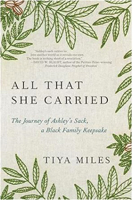
Tiya Miles. All That She Carried: The Journey of Ashley's Sack, a Black Family Keepsake. New York: Random House, 2021. xvii + 385 pp. (cloth), ISBN 978-1-984855-01-5.
H-Net Book Review, published by H-Material Culture, https://networks.h-net.org/h-material-culture (May, 2024).
Reviewed for H-Material Culture by Matthew Fox-Amato (University of Idaho).
When Ruth Middleton took her needle and embroidered part of her family history onto a cloth sack that had been passed down through generations, she recounted a moment of cruelty and resilience. A descendant of people who had been owned in South Carolina, Ruth herself had left the state in the 1910s, moving northward to Philadelphia. From the early twentieth-century North, Ruth looked back toward the 1850s South -- to the lives of her great-grandmother Rose and grandmother Ashley. In a brief ten-line account she told of how Rose, who was enslaved in Charleston, had one day received the most excruciating news: her nine-year-old daughter, Ashley, would be sold. Ruth focused on how Rose responded to this news. In the face of tragedy, Rose went about packing a sack with "a tattered dress," "3 handfuls of pecans," and "a braid of Rose's hair." She gifted it to Ashley, telling her the bag would be "filled with my Love always" (p. 5). The sack and all it held would continue to link Rose and Ashley well after this moment, even though, as Ruth disclosed at the end of her account, the mother and daughter never saw each other again.
Historian Tiya Miles has written a remarkable book about the story of this cloth sack and the lives of the three Black women (Rose, Ashley, and Ruth) who made, preserved, and remade it. In seven gorgeously written chapters, All That She Carried: The Journey of Ashley's Sack, A Black Family Keepsake explores what the sack meant for Rose and Ashley within the confines of slavery in 1850s South Carolina; the significance of Ruth's choices to recount her family history through embroidery, on cloth, and at a particular time (around 1920) in Black history; and the way, at the start of the twenty-first century, the sack entered the public archive (first exhibited at Middleton Place and, since 2016, at the Smithsonian National Museum of African American History and Culture, where it is on loan).[1] At the intersection of material studies, the history of slavery, and Black women's history, All That She Carried is a marvelously insightful book that will no doubt interest specialists and nonspecialists alike.
Miles's book is part of a broader scholarly interest in the material world of antebellum slavery that, over the past few decades, has explored the place of objects and the built environment in the lives of enslaved people and illuminated the more specific history of enslaved craftspeople. In the last thirty years, such scholarship has been especially animated by questions about identity, selfexpression, relationality, and racial power and resistance. Subjects of study have included enslaved people's clothing and hair, their realm of possessions, the architecture that shaped their experiences, the images they exchanged and destroyed, and the material life of the homes they created in bondage and freedom.[2] Diverse in subject matter, this work is guided by the principle that physical objects -- from enslaved Black people's dresses to the iron spikes enslavers added to the fences of their Charleston townhomes -- both reflected and shaped the history of antebellum bondage.
All That She Carried shares this conceptual approach but also distinguishes itself through its sustained attention to the thoughts and emotions of specific enslaved individuals and their descendants. Miles strives to shed light on the facts of these women's lives, suggesting, for example, how Rose and Ashley were likely separated when Ashley was shipped from their enslaver's Charleston manor home to a cotton plantation one hundred miles inland. But it is Miles's foray into the inner domain of idea and feeling that is particularly striking, especially since Rose and Ashley never penned a slave narrative. Here, as Miles compellingly suggests, "attention to material things, especially ones elaborated by words or pictures, opens a route to accessing intangible feelings and desires that can evade the documentary record" (p. 19). In other words, Miles wants to know how the creation, uses, and materiality of the sack offer a winAll That She Carried shares this conceptual approach but also distinguishes itself through its sustained attention to the thoughts and emotions of specific enslaved individuals and their descendants. Miles strives to shed light on the facts of these women's lives, suggesting, for example, how Rose and Ashley were likely separated when Ashley was shipped from their enslaver's Charleston manor home to a cotton plantation one hundred miles inland. But it is Miles's foray into the inner domain of idea and feeling that is particularly striking, especially since Rose and Ashley never penned a slave narrative. Here, as Miles compellingly suggests, "attention to material things, especially ones elaborated by words or pictures, opens a route to accessing intangible feelings and desires that can evade the documentary record" (p. 19). In other words, Miles wants to know how the creation, uses, and materiality of the sack offer a window into the inner worlds of Rose, Ashley, and Ruth.
This attention to interiority is most evident in the sections on Rose, the central figure in All That She Carried. In chapters 3, 4, and 6, Miles unpacks the significance of Rose's act of packing and the things Rose packed. She aims to shed light on Roses's fears, hopes, and values in the face of the slave trade. "Rose likely had a sense of her assigned value as judged by her owner," Miles states, and then asks, "But what of Rose's own list of things? What might it tell us about her scale of values?" (p. 128, emphasis added). Miles grounds her answers to these questions in a broad reading of sources about enslaved women, including the narratives of Harriet Jacobs and Louisa Picquet. In Rose's inclusion of pecans, Miles sees her striving to sustain Ashley materially, through objects with a high nutritional value. Through the gift of the dress, Miles writes, "Rose insisted on Ashley's right to bodily protection and feminine dignity," at once referring to the protection Rose hoped this item would offer a girl against sexual assault as well as the role of clothing as a vehicle through which Black women had long expressed their style and worth (p. 131). And Rose's gift of a braid of hair, Miles asserts, should be seen within a slave society in which enslavers sought retribution against enslaved Black women by cutting their hair. Since enslaved women subverted such bodily violations when they cared for their hair, Rose's exchange of her braid offered Ashley "proof of the kind of selfregard, self-care and mutual aid that sustained life in captivity" (p. 115). Ultimately, Miles suggests that the contents of the cotton bag reveal what mattered most to Rose at this time of tragedy: sustaining Ashley materially and emotionally, through food, clothing, reminders of familial love, and assertions of worthiness.
All That She Carried points the way forward for research on the role of material culture in American slavery and its aftermath. One of the vital contributions it makes is to deepen our understanding of how enslaved people coped with the harsh realities of the internal slave trade. Thanks to the work of such scholars as Dylan C. Penningroth (The Claims of Kinfolk: African American Property and Community in the Nineteenth-Century South [2003]), we have learned much about the contours of enslaved people's possessions. But we have only begun to grasp how they used objects such as clothing to endure forced separations from their loved ones. Miles contextualizes Rose's "emergency kit" within the harrowing history of the internal trade, but she rarely uses the term "resistance," instead opting for the framework of resilience. To what degree do we see other such stories of resilience? In what other ways did people who were owned exchange their own possessions at moments of sale, and to what effect? Moreover, in what ways did other Black families pass down objects through generations and into the twentieth century, as Ashley did with her sack? Might we conceive of Ruth's embroidering as one piece of a broader story about the place of family relics in the private remembrance of slavery? The fact that All That She Carried sparks such queries -- which one might pursue through the Works Progress Administration's interviews of formerly enslaved people in the 1930s or Doc South's collection of slave narratives (https://docsouth. unc.edu/) -- is a testament to the vibrancy of Miles's book.
At its core, All That She Carried is guided by a proposition that scholars of material culture have only begun to pursue: that "material objects," as Miles writes, "can help us to assemble rich histories of the marginalized" (p. 24). There is little doubt Miles makes good on this proposition, offering a model of cultural analysis and elegant narration as well as a profound meditation about Rose, Ashley, Ruth, and the sack that connected them.
Notes
[1]. Earlier discussions of Ashley's sack can be found in Heather Andrea Williams, Help Me to Find My People: The African American Search for Family Lost in Slavery (Chapel Hill: University of North Carolina Press, 2012); and Mark Auslander's work, including "Rose's Gift: Slavery, Kinship, and the Fabric of Memory," Present Pasts 8, no. 1 (2017).
[2]. The following is only a partial list of this interdisciplinary body of work. Starting points on clothing include Shane White and Graham White, Stylin': African American Expressive Culture, from Its Beginnings to the Zoot Suit (Ithaca, NY: Cornell University Press, 1998); and Stephanie M. H. Camp, Closer to Freedom: Enslaved Women and Everyday Resistance in the Plantation South (Chapel Hill: University of North Carolina Press, 2004), chap. 3. On hair, see Jasmine Nichole Cobb, New Growth: The Art and Texture of Black Hair (Durham, NC: Duke University Press, 2022). On architecture, see Maurie D. McInnis, The Politics of Taste in Antebellum Charleston (Chapel Hill: University of North Carolina Press, 2005). On images, see Matthew Fox-Amato, Exposing Slavery: Photography, Human Bondage, and the Birth of Modern Visual Politics in America (New York: Oxford University Press, 2019); and Jennifer Van Horn, Portraits of Resistance: Activating Art during Slavery (New Haven, CT: Yale University Press, 2022), chap. 5. On possessions, see Kathleen M. Hilliard, Masters, Slaves, and Exchange: Power's Purchase in the Old South (New York: Cambridge University Press, 2014); and Thavolia Glymph, Out of the House of Bondage: The Transformation of the Plantation Household (New York: Cambridge University Press, 2008), chap. 7. On the home, see Whitney Nell Stewart, This Is Our Home: Slavery and Struggle on Southern Plantations (Chapel Hill: University of North Carolina Press, 2023). Winterthur Portfolio recently published a rich special issue on the subject of slavery and material culture: Catherine Dann Roeber and Jennifer Van Horn, eds., "Enslavement and Its Legacies," Winterthur Portfolio 54 no. 4 (2020): 199-299.
[Citation: Matthew Fox-Amato. Review of Miles, Tiya, All That She Carried: The Journey of Ashley's Sack, a Black Family Keepsake. H-Material-Culture, H-Net Reviews. May, 2024. This work is licensed under a Creative Commons Attribution-Noncommercial-No Derivative Works 3.0 United States License. H-Net permits the redistribution and reprinting of this work for nonprofit, educational purposes.]
[Return to table of contents]
Book Review

Martin Tsang, ed. Spirited Diasporas: Personal Narratives and Global Futures of Afro-Atlantic Religions. Gainesville: University of Florida Press, 2023. Illustrations. 227 pp. (paper), ISBN 978-1-68340-383-8.
H-Net Book Review, published by H-Caribbean, https://networks.h-net.org/h-caribbean (April, 2024).
Reviewed for H-Caribbean by Elaine Penagos (Trinity University).
The collection assembled in Martin Tsang's Spirited Diasporas: Personal Narratives and Global Futures of Afro-Atlantic Religions accomplishes a feat through its compilation of individual stories. The publication of this book by an academic press points to the importance of an all-too-frequent occurrence that scholars of Afro-Atlantic religions discuss among themselves but seldom interrogate with significant depth. To be sure, the initiation of non-African-descended "outsiders," typically non- Black individuals or those without cultural, ethnic, or familial ties, into Afro-Atlantic religions is not novel, and this phenomenon has been noteworthy since at least the mid-1800s when Andres Facundo Cristo de los Dolores Petit founded the first Abakuá lodge in Cuba that admitted white members.
However, the admittance of said "outsiders" into such traditions as Regla de Ocha (Santería), Vodou, and other Afro-Atlantic religions is a documented historical occurrence that has garnered relatively little scholarship. Among the few notable exceptions are Kamari Maxine Clarke in Mapping Yorùbá Networks: Power and Agency in the Making of Transnational Communities (2004) and Tracey E. Hucks in Yoruba Traditions and African American Religious Nationalism (2012), both writing about Walter Eugene King, Ofuntola Oseijeman Adelabu Adefunmi, who in the mid-twentieth century became the first African American initiated into Regla de Ocha in Matanzas, Cuba. As respectively analyzed by Clarke and Hucks, Adefunmi's story, from cultural outsider to initiated and culture (re)making insider as the founder of Oyotunji Village, remains among the very few that has been taken up by scholars to examine why the cross-cultural phenomenon of "outsider" initiations matters for the fields of history, religious studies, and diaspora studies, to name just three. Spirited Diasporas is, therefore, responding to a noticeable gap within Africana religious studies, where "outsiders" and scholar/practitioners take center stage as participants in the proliferation of these global religions.
Following Solimar Otero's foreword and Tsang's introduction, Spirited Diasporas contains twelve chapters, most of which deal with Regla de Ocha, with two dedicated to Vodou and one to Candomblé. The book includes a glossary and recommended reading list, which specialists and nonspecialists will find helpful. Otero provides a scholarly and practitioner-informed foreword, succinctly laying out useful frameworks through which readers might engage Tsang's book. In addition to Otero's acknowledged presence of Oshún, the orisha of fresh waters in the diaspora, throughout the book, Spirited Diasporas is also marked by the presence of another spirit, Clay Keck, Afolabí, who makes an appearance in several of the book's chapters. An initiated priest of Yemayá (orisha of the sea in the diaspora) for many years before his passing, Afolabí helped several of the book's contributors, Tsang included, find a home in Regla de Ocha. Similar to the aptness of Oshún's presence in Spirited Diasporas, it is fitting that Afolabí, himself initially an "outsider," established one of Michigan's most well-known iles, orisha houses. Spirited Diasporas is, in many ways, an effort blessed by las dos aguas, the two waters owned by Oshún and Yemayá.
As with any edited volume, some chapters stand out from the rest. Tsang’s scholarly introduction is crucial to appreciating the range of voices and objectives across the various chapters. He situates the book as an autoethnographic endeavor, characterizing the chapters as “condensed ethnographic pieces ... in first-person prose” (p. 18). Some chapters lean into what I would characterize as the book’s more confessional objectives, providing readers with perspectives on the various ways that the orisha, lwa, and other Africana deities make themselves known in the lives of would-be practitioners. Importantly, the nonscholarly chapters make plain that the deities of Africa and its diaspora are welcoming and access. accessible to a diverse and global population. Although there is an undeniable value in aggregating “narratives of the sacred as written by individuals encountering Afro-Atlantic spirituality through initiation,” my concern with a few of the chapters is mainly about how they might be read, particularly by nonspecialists, as potentially exoticizing narratives about Afro-Atlantic traditions (p. 3). Not surprisingly, the chapters authored by scholars, including Tsang, Giovanna Capponi, Ivor Miller, and Michael Atwood Mason, are more carefully worded and sidestep some of the language that many scholars of Afro-Atlantic religions try to avoid or, at the very least, take time to unpack in the classroom.
As a non-Black Cuban American steeped in the academic study of an Afro-Atlantic religion, I appreciate the space for dialogue Tsang opens up with this volume. Spirited Diasporas would make a discussion-worthy accompaniment to various other monographs about Afro-Atlantic religions that take up issues of globalization and transnational religions. One recent example is Eziaku Atuama Nwokocha's 2023 ethnographic study, Vodou en Vogue: Fashioning Black Divinities in Haiti and the United States, in which she begins to pull on some of the threads surrounding the issue of white practitioners in Haitian Vodou. While Nwokocha privileges the perspectives of Black Vodou practitioners in her analysis, Tsang's edited volume gives readers insight into the other side of the conversation, presenting an assemblage of deeply personal stories that reveal the inclusivity of Afro-Atlantic religions and their deities. Other books that might pair well in the classroom with Spirited Diasporas include C. Lynn Carr's A Year in White: Cultural Newcomers to Lukumi and Santería in the United States (2016) and Karen McCarthy Brown's classic, Mama Lola: A Vodou Priestess in Brooklyn (1991).
While the book is accessible to both specialists and nonspecialists, it is better suited for those with some familiarity with Afro-Atlantic religions. Spirited Diasporas does not delve deeply into the particularities of each religion it covers, but it does offer an overview of some of the most salient features of Afro-Atlantic religions. Overall, Spirited Diasporas is an important addition to the body of work that exists about Afro-Atlantic religions. With Tsang's careful editorial eye, the book is a worthwhile contribution to the Africana religious studies landscape and will hopefully inspire scholars within the field to study this phenomenon in light of transnationalism and globalization more deeply.
[Citation: Elaine Penagos. Review of Tsang, Martin, ed., Spirited Diasporas: Personal Narratives and Global Futures of Afro-Atlantic Religions. H-Caribbean, H-Net Reviews. April, 2024. This work is licensed under a Creative Commons Attribution-Noncommercial-No Derivative Works 3.0 United States License. H-Net permits the redistribution and reprinting of this work for nonprofit, educational purposes.]
[Return to table of contents]

©2024 African Diaspora Archaeology Network
Copyright and all rights reserved by
individual authors for each article.
Please send comments, suggestions,
or questions to the editor
Last updated: June 24, 2024
Text only menuSearch
|















